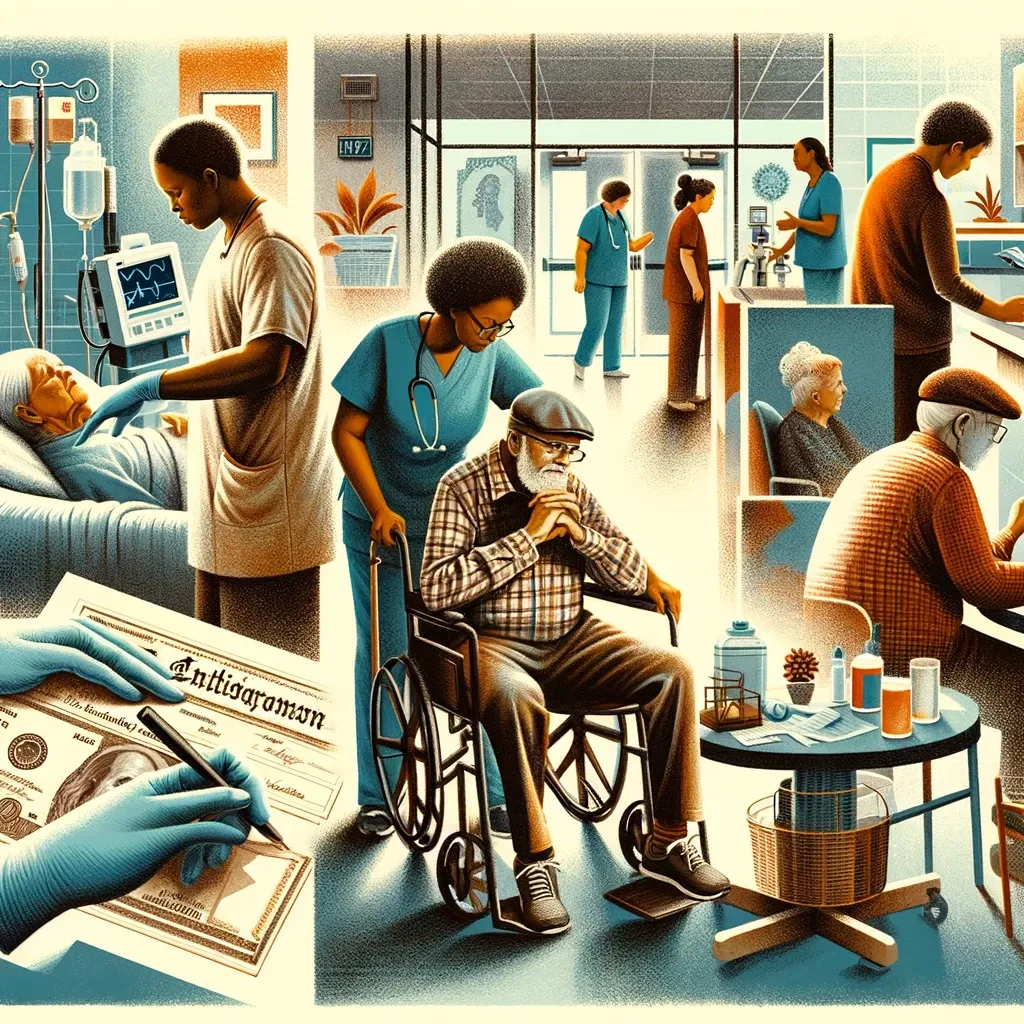Tackling the Home Health Care Worker Shortage Strategies for a Sustainable Future
Explore the future of home health care, where a clinical ladder system transforms care quality. This vision showcases workers using advanced practices in settings that blend nature with technology, emphasizing growth, innovation, and accessible care for all.

The Crucial Role of Home Health Care Workers
The shortage of direct care workers presents a growing challenge as the demand for their services increases with the aging population. The direct care workforce, including aides and personal care assistants, plays a vital role in delivering long-term services and supports (LTSS) that allow seniors and individuals with disabilities to live independently in their homes. However, the sector is struggling to recruit and retain the workforce needed to meet this demand. Workforce shortages, exacerbated by factors like COVID-19 and slow labor growth, further strain service delivery and the ability to meet the increasing need for long-term care.
The Vital Services Provided by Home Health Care Workers
Understanding the Scope of Care
Home health care workers perform a broad range of tasks that are crucial for the daily living and medical care of millions of Americans. From assisting with personal hygiene and meals to administering medication and providing emotional support, these professionals are the backbone of community-based health care. The roles of home health aides, personal care aides, and certified nursing assistants (CNAs) are fundamental in providing care and support to individuals with health care needs, yet they differ significantly in their responsibilities, training requirements, and the environments in which they can work. Understanding these differences is crucial for families seeking care for their loved ones and for individuals considering careers in these fields.
Home Health Aides (HHAs)
Home health aides primarily assist patients in their homes or in residential care facilities with daily living activities such as bathing, dressing, and eating. Their role may also include checking vital signs under the supervision of a registered nurse or another healthcare professional. HHAs are often employed by home health agencies that are regulated by state and federal laws, requiring them to undergo specific training programs. Additionally, home health aides must complete annual continuing education hours to maintain their certification and competencies. The Home Health Aide Training Program (HHATP) varies by state but generally includes both classroom instruction and hands-on clinical experience. Training covers basic personal care, understanding patient rights, emergency procedures, and some clinical tasks like observing and reporting changes in the patient’s condition.
Personal Care Aides (PCAs)
Personal care aides share similar duties with home health aides in assisting with daily activities. However, their focus is more on non-medical support, including light, housekeeping tasks, meal preparation, and companionship. PCAs do not typically perform clinical tasks and their training, which can be less formal and vary more widely than that for HHAs, often focuses on the essentials of personal care, communication skills, and basic safety. PCAs are commonly employed directly by families or through private care agencies and may work in various settings, including clients' homes, group homes, and day services programs.
Certified Nursing Assistants (CNAs)
Certified Nursing Assistants receive more formal training compared to HHAs and PCAs, making them qualified to perform additional duties, particularly in clinical care. Workforce training is crucial for CNAs to perform their duties effectively, ensuring they can meet the high standards of care required in various healthcare settings. CNAs work under the supervision of registered nurses or licensed practical nurses and are capable of performing a broader range of tasks, including taking vital signs, assisting with medical equipment, and providing more specialized care for patients with chronic illnesses or those in rehabilitative care. The training for CNAs is more comprehensive, requiring completion of a state-approved education program and passing a competency exam. CNAs are found in a variety of healthcare settings, including hospitals, nursing homes, assisted living facilities, and home health care.
Monitoring and Supervision
The supervision of home health aides and personal care aides is typically conducted by registered nurses (RNs) or licensed practical nurses (LPNs) within the home health care team. These nurses are responsible for creating care plans, monitoring the patient's health condition, and ensuring that client's care aides perform their duties according to professional standards and specific patient needs. RNs play a critical role in training and evaluating the performance of HHAs and PCAs, particularly in teaching them how to respond to changes in patients' conditions and how to carry out specific healthcare tasks safely and effectively.
Work Environments
- Home Health Aides and Personal Care Aides primarily work in clients’ homes, assisted living facilities, and sometimes in residential care settings. Their work is largely focused on helping individuals maintain their independence and quality of life in a home-based setting.
- Certified Nursing Assistants have a broader range of potential work environments, including hospitals, nursing homes, assisted living facilities, and home health care settings. Their formal training allows them to perform more complex care tasks, suitable for various institutional and home-based care settings.
In summary, while HHAs, PCAs, and CNAs share the common goal of supporting patients with their health and daily living needs, the scope of their duties, training requirements, and work environments differ significantly. These distinctions ensure that care is provided in a manner that best matches the needs of the patient, whether it’s basic assistance with daily activities, non-medical personal care, or more specialized clinical support.
Facing the Challenges: What Home Health Care Workers Endure
Overcoming Low Wages and Job Injuries
Home health care workers, including home health aides, personal care aides, and nursing assistants, are integral to the delivery of direct care services to individuals needing assistance with daily living. Understanding the challenges faced by these workers requires comprehensive workforce data. Despite their indispensable role, the Bureau of Labor Statistics highlights that these health care professionals often face financial instability due to low wages and minimal benefits. This economic strain is compounded by a high risk of job-related injuries, as these healthcare workers must frequently engage in physically demanding tasks such as lifting patients, which can lead to back injuries, strains, and other health issues. To measure turnover rates and improve workforce stability, it is essential to collect workforce data systematically.

Aides work in different settings
Challenges of the Home Health Aides/ Home Health Care Workers
The challenges extend beyond physical risks. Home health care workers often operate in isolated environments, providing care in patients' homes or assisted living facilities without immediate support from colleagues. This isolation can exacerbate the stress associated with their job duties, from monitoring vital signs to assisting with personal care and managing chronic conditions. Despite the essential nature of their work, the compensation and benefits offered to these workers rarely reflect the complexity and importance of their tasks, leading to job dissatisfaction and high turnover rates. These factors not only affect the wellbeing of the workers but also contribute to the persistent shortage in the home health care workforce.
The Root Causes of the Workforce Shortage
Demographic Shifts and Economic Factors
The growing demand for home health services, driven primarily by an aging population and increased prevalence of chronic illnesses, starkly contrasts with the stagnant wages and challenging working conditions faced by home health care workers. As the senior population continues to grow, the need for long-term services also increases, influencing workforce dynamics within the long-term care sector. As the senior population continues to grow, the need for skilled nursing care, occupational therapy, and other home health services intensifies, highlighting the critical role of home health aides, personal care aides, and other direct care workers in maintaining the health and independence of millions. Nursing facilities play a crucial role in providing round-the-clock nursing and personal care for individuals with chronic conditions, addressing both short-term rehabilitation and long-term care needs.
Economic Factors the Impact Home Health Care Professionals
However, the economic factors affecting the labor force in this sector are significant barriers to workforce expansion. The Bureau of Labor Statistics and the National Research Council have documented the disparity between the rising demand for home health services and the compensation offered to workers. This imbalance makes the profession less attractive to potential entrants, despite the positive job outlook and the rewarding nature of patient care. Furthermore, the variability in training requirements—ranging from a high school diploma to more formal training through community colleges or vocational schools—adds another layer of complexity to entering the field.
The combination of demographic shifts and economic challenges has led to a critical shortage of home health care workers. To address this, there needs to be a concerted effort to improve wages, provide comprehensive benefits, and enhance training and support for these essential members of the health care team. Additionally, policies and initiatives from health and human services agencies that support the expansion of community-based services and the use of Medicaid services to fund home health care could play a pivotal role in attracting new workers to the field.
Improving the conditions for home health care workers is not only a matter of fairness and equity but also a crucial step towards ensuring that the growing senior population and individuals with chronic conditions can continue to receive the high-quality care they need in their preferred settings.
Solutions and Strategies for Addressing the Shortage
Enhancing Worker Recruitment and Retention
Improving wages and benefits, offering career advancement opportunities, and standardizing training programs are key strategies to attract and retain home health care workers. The importance of home and community-based services in supporting the expansion and sustainability of the workforce cannot be overstated. Additionally, policy changes and increased funding for home health services can support the expansion and sustainability of the workforce.

The Path Forward for Home Health Care: Introducing a Clinical Ladder for Aides
The pressing shortage of home health care workers presents a critical challenge that demands immediate and innovative solutions. A vital step towards addressing this issue involves redefining the value and investment in home health aides, personal care aides, and certified nursing assistants. These essential workers form the backbone of home health care, providing indispensable services that enable the senior population and individuals with chronic illnesses to live with dignity and independence in their preferred environments. To foster a sustainable and effective home health care system, introducing a clinical ladder that offers ongoing education and certification opportunities emerges as a promising strategy. This approach not only acknowledges the vital role of these workers but also provides a clear pathway for career advancement and financial improvement.
Enhancing Professional Development through Continuous Education
The concept of a clinical ladder for aides is centered around the principle of lifelong learning and professional growth. Continuous education helps home health care workers provide services more effectively. By integrating ongoing education programs and offering certification opportunities, home health care workers can acquire new skills, deepen their knowledge, and stay abreast of the latest best practices in patient care. Community colleges, vocational schools, and online platforms can serve as valuable resources for delivering these educational programs, covering topics from advanced patient care techniques to specialized areas like occupational therapy, physical therapy, and skilled nursing care.
Certifications as Stepping Stones for Career Advancement
Offering a range of certification options tailored to the diverse roles within home health care can empower aides to specialize in areas that match their interests and career aspirations. For instance, a personal care aide might pursue a certification in geriatric care, while a home health aide could focus on acquiring skills in chronic illness management. These certifications not only enhance the quality of care provided to patients but also elevate the professional standing of aides, making them more valuable to their employers and the health care system at large.
A Pathway to Better Pay and Job Satisfaction
The introduction of a clinical ladder addresses one of the core challenges faced by home health care workers: the need for better compensation and job satisfaction. By recognizing and rewarding the acquisition of new skills and certifications, employers can offer progressive salary increments rewarding career move, thereby acknowledging the professional growth and contribution of their aides. This not only improves the financial well-being of home health care workers but also contributes to greater job satisfaction and loyalty, thereby reducing turnover rates and alleviating the workforce shortage.
The Role of Stakeholders in Supporting the Clinical Ladder
The successful implementation of a clinical ladder for home health care aides requires the active involvement of various stakeholders, including health and human services agencies, home health agencies, educational institutions, and policymakers. These entities must collaborate to establish standards for certification, and training requirements vary ensure the accessibility of educational programs, and provide funding or incentives to encourage participation. Furthermore, embracing technology through the use of telehealth and mobile health applications can supplement traditional education and support the continuous learning of home health care workers.
A Vision for the Future of Home Health Care
The introduction of a clinical ladder for home health care aides represents a forward-thinking solution to the workforce shortage plaguing the home health care sector. By investing in the professional development and well-being of these essential workers, we can enhance the quality of care delivered to the growing senior population and those with chronic conditions. This approach not only benefits patients and their families but also contributes to a more robust and resilient home health care system. Through collaborative effort and a commitment to valuing home health care workers, we can pave the way for a future where quality care is accessible to all in their preferred setting.

FAQ: Tackling the Home Health Care Worker Shortage: Strategies for a Sustainable Future
What roles do home health care workers play in patient care?
Home health care workers, including home health aides, personal care aides, and certified nursing assistants, play crucial roles in assisting patients with daily living activities, such as bathing, dressing, and meal preparation. They also provide direct care services, monitor vital signs, and offer emotional support to patients and their family members.
How significant is the demand for home health care workers?
According to the Bureau of Labor Statistics, the demand for home health care workers is expected to grow significantly due to the aging population and the preference of many seniors to receive care in their homes. This job growth reflects the increasing need for personal care and medical care services provided by home health care professionals.
What challenges do home health care workers face?
Home health care workers face challenges such as low wages, minimal benefits, high risk of job-related injuries, and often a lack of formal training. These challenges contribute to high turnover rates and a shortage of workers in the field.
How can the home health care worker shortage be addressed?
Addressing the shortage requires a multi-faceted approach that includes improving wages and benefits, providing formal training and career advancement opportunities through community colleges and vocational schools, and enhancing support from health and human services for these essential workers.
What is the role of registered nurses (RNs) in home health care?
Registered nurses play a pivotal role in home health care by developing care plans, supervising home health aides and personal care aides, and ensuring high-quality patient care. They are essential members of the home health care team, coordinating clinical tasks and providing training and support to other health care workers.
Where do most home health aides and personal care aides work?
Most home health aides and personal care aides work in clients' homes, assisted living facilities, or through home health agencies. They provide essential care that allows individuals to live independently in their preferred environment.
What are the training requirements for home health aides?
Training requirements for home health aides vary by state but typically include a combination of classroom instruction and hands-on clinical training. They must complete a competency exam to demonstrate their skills in providing care. Formal training programs for certified nursing assistant are available through community colleges, vocational schools, and sometimes through home health agencies.
How can family caregivers support the home health care team?
Family caregivers can support the home health care team by providing information about the patient's medical history, preferences, and needs, collaborating with home health agency and on care plans, and ensuring a safe and supportive environment for both the patient and the home health care workers.
What is the job outlook for home health care workers?
The job outlook for home health care workers is positive, with expected job growth in the sector due to the aging population and the increasing preference for home-based care. This growth underscores the importance of these workers in the health care system and the need to address the current shortage of home health care aide.
Can home health care workers provide medical care?
While most home health aides and personal care aides focus on non-medical support, certain other home health aide and care workers, like certified nursing assistants and those with special training, can perform clinical tasks under the supervision of a registered nurse or licensed practical nurse. This includes tasks such as monitoring blood pressure, assisting with the use of medical equipment, and other basic medical care activities.
You might also like this article:







